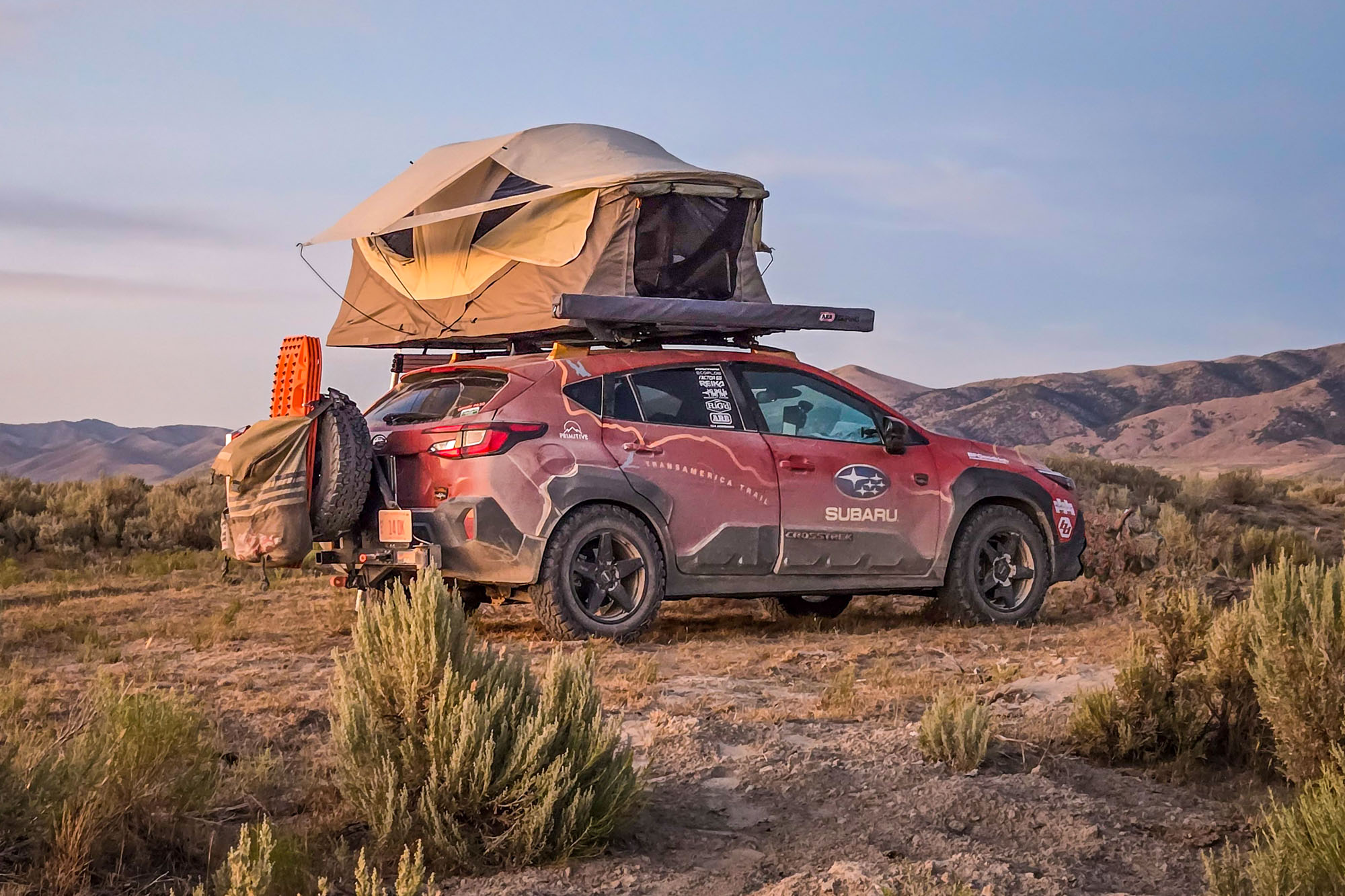My wife, Mercedes Lilienthal, and I just got done with a 29-day crossing of the U.S. in a 2025 Subaru Crosstrek Wilderness. We slept on top of it, cooked out of the back of it, and drove the car more than 7,100 miles (and more than 3,100 were off pavement) on the TransAmerica Trail (TAT) from the Atlantic Ocean in North Carolina to the Pacific Ocean in Oregon.
While we’ve done long-distance travel in unconventional vehicles before, we’d never traveled this long in a car this small. With our modifications, it not only worked, but worked well.
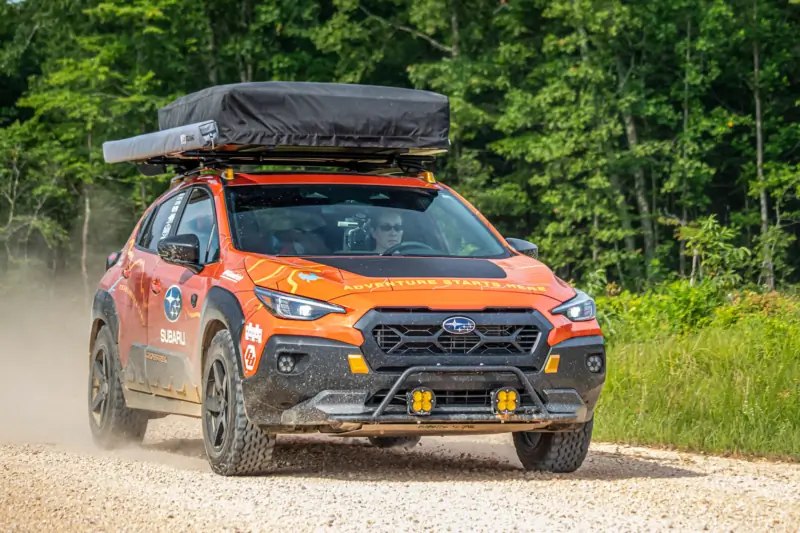
The Subaru Crosstrek Wilderness (“CTW”) is compact, but can be a surprisingly good platform for adventure travel, though not without limitations. With the right upgrades, these cars can be competent overland vehicles.
Let’s dive into some of my recommendations to make the CTW ready for overland adventures.
First: A Place to Sleep
No matter what you drive (or ride), if you’re on a multiday overland trip, you’ll need to figure out a sleeping setup. Will you sleep on, in, or by your vehicle?
Rooftop Tent Deployed




On our TAT trip, we used a rooftop tent for overnight accommodations, choosing to sleep atop our Subie. A rooftop tent mounts to a roof rack’s cross bars, are quick to set up, good in foul weather, and keeps you off the ground and away from mud, rocks, water, and critters. We slept 23 of 29 nights atop our CTW in a Thule Approach. We affectionately called the setup “Chateau Crosstrek.”
Rooftop tents aren’t without downsides. They’re pricey, heavy, and sap a vehicle’s fuel economy. On a small car like a CTW, you also usually can’t use other rooftop accessories, such as cargo boxes or baskets. For us, a rooftop tent’s pros outweighed the cons for this trip.
Sleep Inside
If you’d rather doze in your CTW versus on top of it, several companies offer inflatable mattresses to sleep inside your Subie.
Luno offers pads specifically for the Crosstrek. While I haven’t slept on one yet, I laid on a sample at Overland Expo West, and it was plenty plush.
Keep in mind that any interior inflatables will limit your ability to keep gear inside the car. But, if you’re traveling light, this can be a quiet, secure, and comfortable option. Plus, if you don’t have a rooftop tent, you can use a roof cargo box and keep gear up there.
Ground Tent Option
A trusty third option is the good old ground tent. They’re lightweight and can pack small, but you’re snoozing on terra firma. We’ve traveled around Iceland for weeks at a time, sleeping in our MSR Hubba Hubba Tour 3 ground tent with little complaint.
Shade & Shelter
In this vein is another creature comfort: a car-based awning. We ran an ARB Soft Case Awning With Light 2.0M on our TAT CTW. We deployed it at camp to provide shade. But, you can buy walls to turn it into a room that you could sleep in.
Swing-Away Tire Carrier: Not Just for a Spare Tire
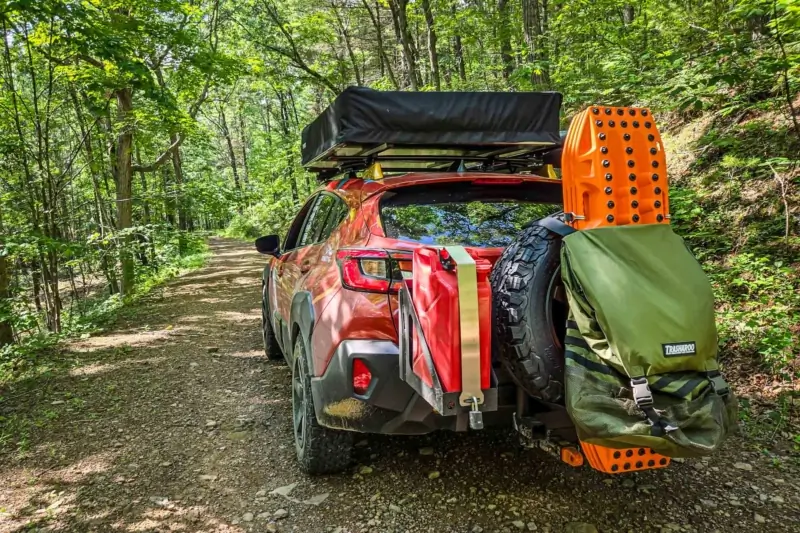



Assuming your CTW has a trailer hitch with a 2-inch receiver, several companies offer hitch-mounted swing-away rear tire carriers. We used a RiG’D Supply UltraSwing Short-Fit on our TransAmerica Trail CTW. But these swing-aways can carry more than just a spare tire.
For example, our RiG’D UltraSwing not only carried our full-size spare, our MAXTRAX XTREME traction boards and a Trasharoo spare-tire trash bag, but we also kept laundry here.
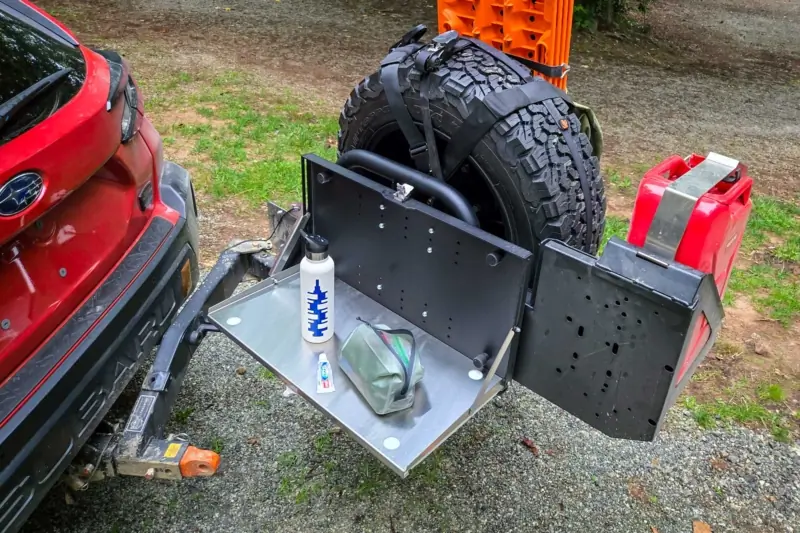



But wait, there’s more! We also had the RiG’d SideHack extension, allowing us to carry a jerrycan of gas. Lastly, the company’s optional fold-down UltraTable let us prep food, lay maps out, and get work done wherever we were.
FYI, the UltraSwing has a built-in 2-inch receiver so you can still utilize hitch-mounted accessories, like a Factor 55 HitchLink 2.0 recovery point, which is what we did. A swing-away setup can help free up space inside the car and add versatility.
Adding Armor
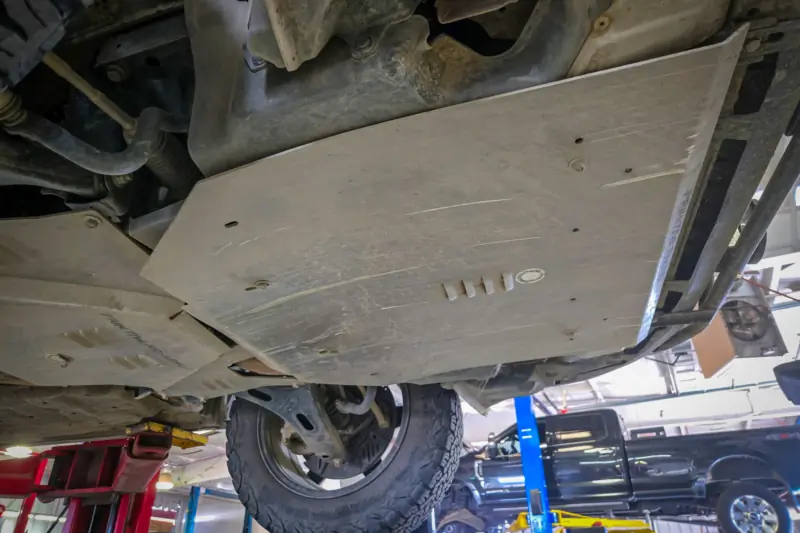



Aftermarket skid plates will help protect your Subaru’s underbelly. While the CTW has an ample 9.3 inches of ground clearance, there isn’t much factory underbody protection.
We ran Primitive Racing’s skid plate set, which included front, mid, and rear differential plates made from 3/16-inch aluminum. They saw lots of action crossing the Appalachian and Rocky Mountains, as well as terrain in Moab and Oregon — they were crucial upgrades.
Even if you’re simply doing dirt roads, durable, thick skid plates can be a bit of insurance that every overland rig should have, especially Subarus.
Talking Tires & Wheels
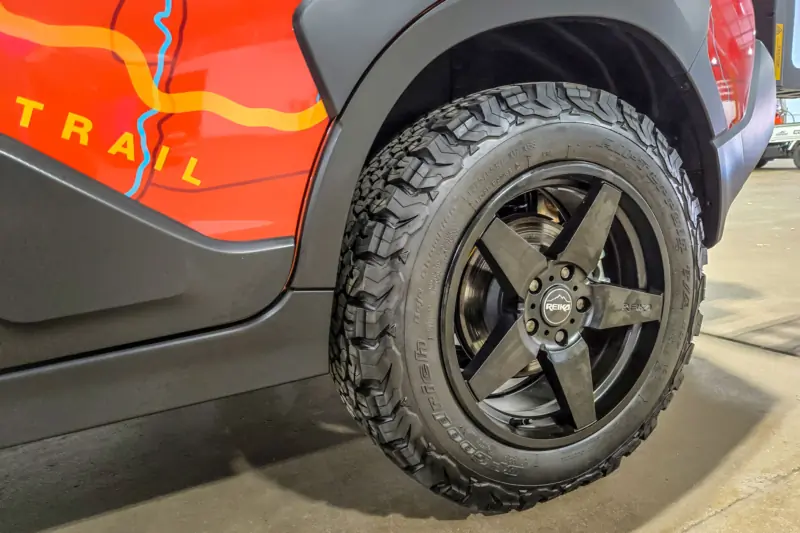



From the factory, the CTW wears Yokohama Geolandar A/T G015 all-terrain tires with ample traction and a quiet ride. However, you may want to choose more aggressive rubber like we did. We selected BFGoodrich’s All-Terrain KO2 tires with beefier lugs and strong sidewalls. We run multiple sets of KO2s on our personal rigs and know and trust them.
(The newer BFG KO3 tires weren’t available in our fitment at the time.)
Note, the KO2s are noisier than the CTW’s factory Yokohamas. We also went from a 225/60/17 to a 225/65/17, giving about 0.9 inches of lift. Although the speedometer and odometer were off by 3.3%, the clearance was worth it.
For a more aggressive stance, we added Reika R15 Seeker wheels in matte black. They’re an inch wider and have more offset than the stock wheels.
Need more traction than an all-terrain? Some companies are making mud-terrain tires in Subaru sizes. Keep in mind, they’ll have lots of road noise!
Suspension Stuff
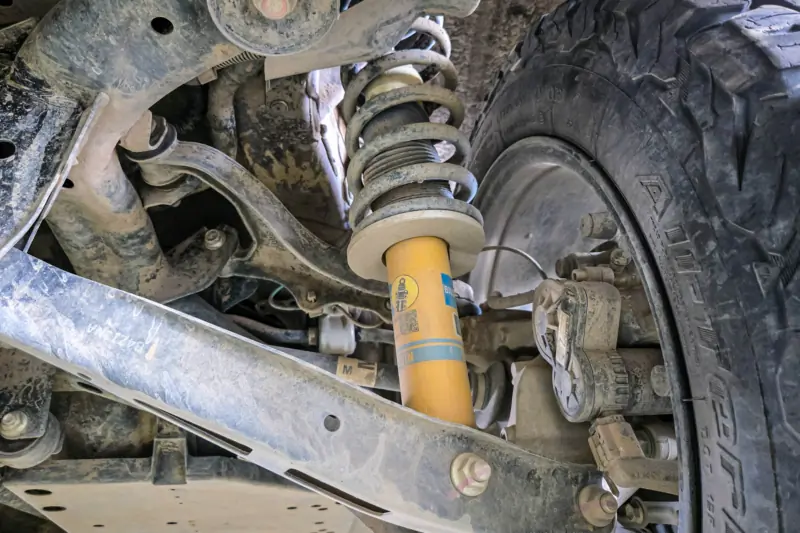



If you’re going to carry extra weight in your CTW, consider upgrading its struts and springs. A variety of aftermarket companies offer suspension upgrades for these vehicles.
We turned to Oregon-based Primitive Racing, which supplied a set of Bilstein B6 struts and rear King Springs. The B6s are an OEM replacement strut with increased durability and performance.
The rear King Springs were slightly taller and stiffer than stock. They were essentially overload springs for our extra weight. We could’ve used a stiffer King Spring (which is available), and we’d use those if we would redo this trip.
Many spring companies offer different heights and stiffnesses, so be sure to consider what you’ll need for your build. Some Crosstrek lift kits require more than just springs and struts. There are subframe drops, camber correction kits, and other things you can get.
I also wouldn’t recommend going over 2 inches of lift, as it can throw off the car’s suspension geometry and wear CV joints prematurely.
Adding Auxiliary Lights
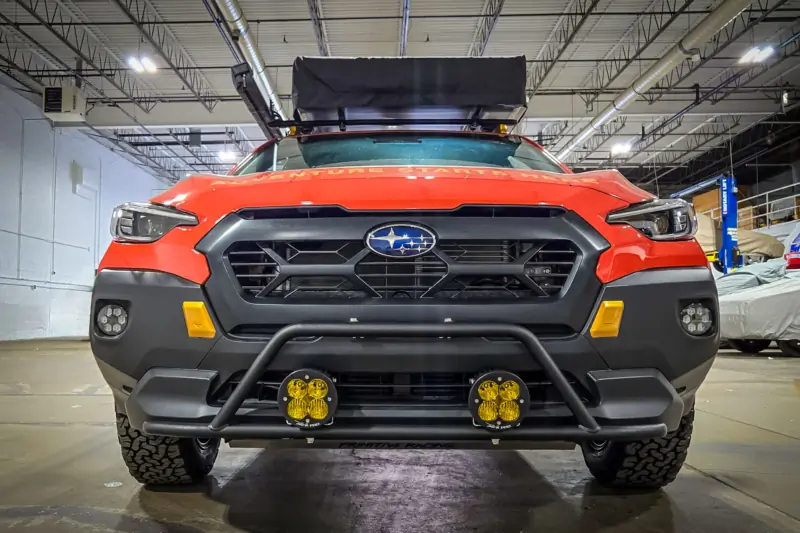



Adding extra lights to your overlanding rig is a must-have for us. Extra lumens can go a long way in the backcountry. Lights can vary drastically in price and quality, so be sure to do your research.
We installed a set of Baja Designs XL-R Pro LED lights on our TAT CTW. Several options are available. We chose the versatile combo beam with a yellow lens; it helped in low-visibility trail situations, such as the dark forests of Appalachia. When you select aux lights, ensure they’ll fit where you intend to mount them. Also, think about how you’ll mount them.
We turned to Rally Innovations and its Rally Light Bar mount. We’d used this product previously, and it’s super sturdy, made in the USA, and fits right. They even stood up to the occasional bump while crawling up rocks on the trails.
Running a Refrigerator
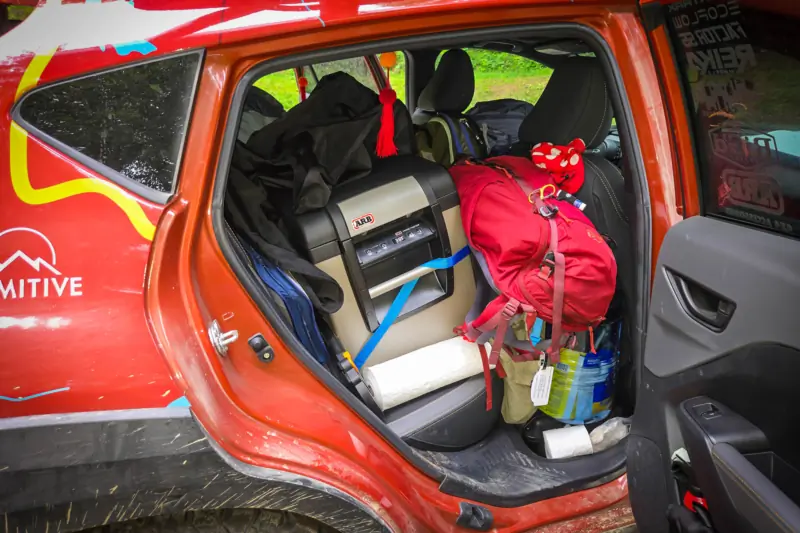



For years, we’ve used 12V fridge/freezers in lieu of a traditional cooler to keep our food and drink cold on the road — no ice needed. These plug into a 12V outlet or can be wired directly to the car.
For this trip, we used an ARB Classic Series II 50 quart Fridge Freezer. It was on for 29 days straight, keeping everything from meats and cheeses to sodas and medicine cold and fresh.
Fridges and freezers can run the gamut in terms of features and sizes. Some have Bluetooth control, voltage protection, and even dual zones for different temperatures. Less-expensive units may have less efficient compressors and don’t get as cold.
The downsides to 12V fridges? They can take up lots of space. Half of our back seat was dedicated to our fridge freezer.
Also, if you aren’t driving around for a few days, 12V fridges can drain your vehicle battery. Fridges with voltage protection will shut down before draining your battery completely, however. Good for the car, not so much for its contents.
Traditional coolers will still work, but you’ll need to regularly get ice, and if you’re off-grid for a while, that’s an issue. But coolers can be smaller and far less costly than electric off-road fridges.
Staying Charged Up
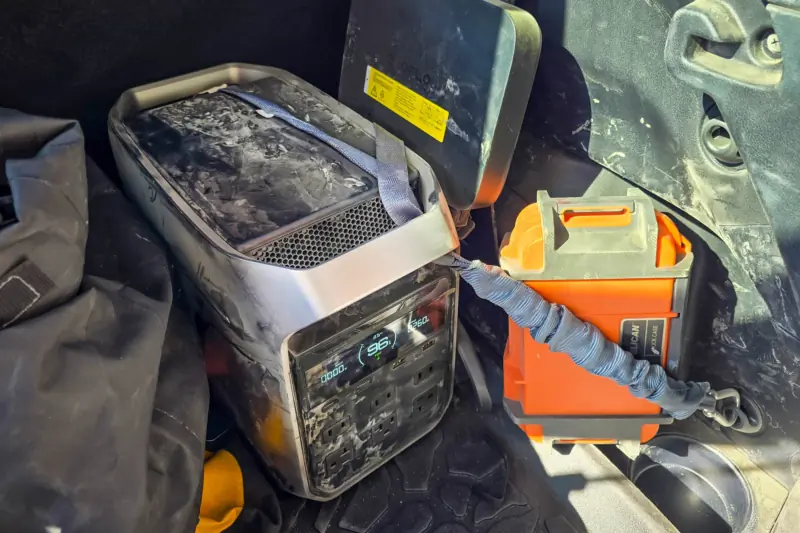



Most of us travel with loads of electronics — from phones and laptops, to cameras and GPS units — everything needs charging. A car can only charge so much, so supplemental power is a great idea. In lieu of a gas generator, many people use portable power stations, especially in smaller vehicles like a CTW.
There are various power stations available that are great for off-grid overlanding use in a CTW. They range widely in size, power, and price. We’ve used units from different manufacturers, all of which have their pros and cons. But look at a power station’s features, like the kind of USB ports, the number of 120V plugs, and how you recharge the unit.
Maybe you don’t buy a big fancy unit, and a small power station or battery pack will suffice. But, if you’re bringing a 12V fridge, two laptops, two phones, two GPS units, two DSLR cameras, and a Starlink … maybe not. Hey, we’re journalists here!
We used an Ecoflow DELTA 3 Plus in our TAT CTW. It offered 1,024Wh of capacity and 1,800W of output, and it was very quiet. It also had a multitude of plugs allowing us to power and charge at camp.
We used Ecoflow’s 800W Alternator Charger with it. This unit runs between the car’s battery and the Ecoflow power station. Using the Ecoflow app and the Alternator Charger, you can have the car recharge the DELTA 3 Plus as you drive.
At night, the unit can be set to reverse charge, sending power from the DELTA 3 Plus power station to the Subaru’s 12V car battery. This helps ensure the car’s battery doesn’t get run down at night, as our fridge freezer would be on all night long with other items potentially charging, too.
Solar Charging
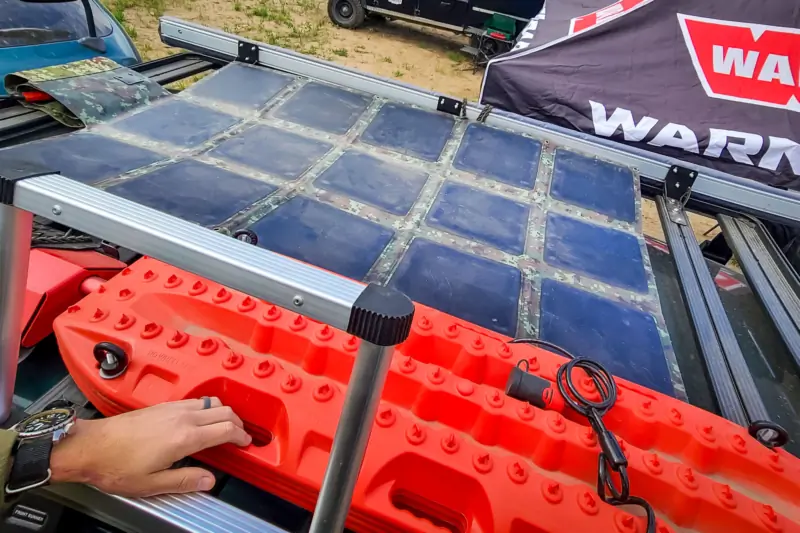



Solar is another popular option to charge your power station. Portable panels come in an array of sizes, shapes, outputs, and styles. From hard panels to flexible solar blankets, solar can be a great choice.
For maximum efficiency, you need sun and lots of it, which isn’t always possible. Plus, some panels can take up a fair bit of space, unless they’re permanently affixed to the car’s hood or roof.
In smaller adventuremobiles, I opt for portable solar blankets. These can pack down to about the size of a laptop, but unfolded, can provide substantial power to whatever it is you’re recharging.
Watch Your Wilderness’s Weight
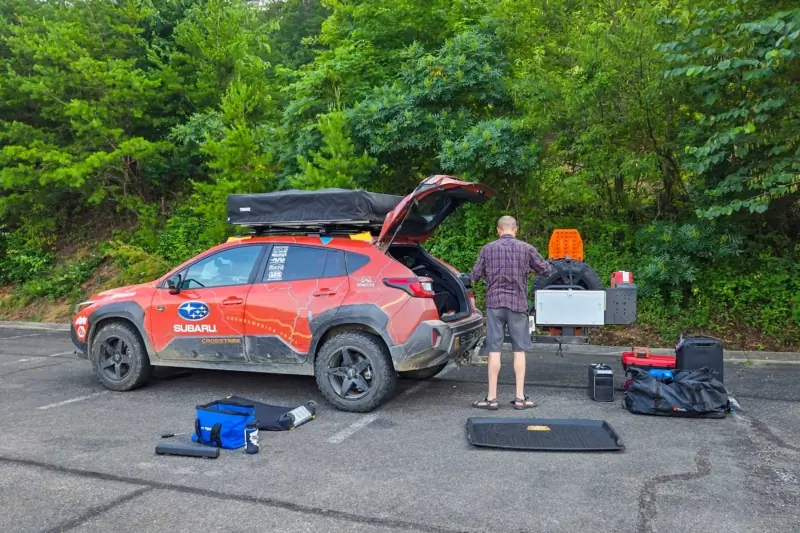



Some people joke about overlanding as “overloading.” After all, adding all this stuff to your vehicle, no matter what it is, can weigh it down.
We were cognizant of our vehicle weight on TAT, and you should be on your Crosstrek. Thankfully, the CTW has a surprisingly high gross vehicle weight rating (GVWR) of 4,817 pounds. The GVWR is the maximum weight a car can be with its passengers, fuel, cargo, and anything bolted to it.
The CTW’s curb weight (the weight without passengers, cargo, or bolt-ons) is 3,369 pounds.
If you subtract that from the GVWR, you get 1,148 pounds, which is the amount of weight you can add safely. And since that’s a safety thing, staying under the GVWR is advised. Otherwise, it can affect your rig’s acceleration, handling, and braking.
All your mods and gear can add up quickly, so stay aware of your weight.
Know the Vehicle’s Limitations — And Yours
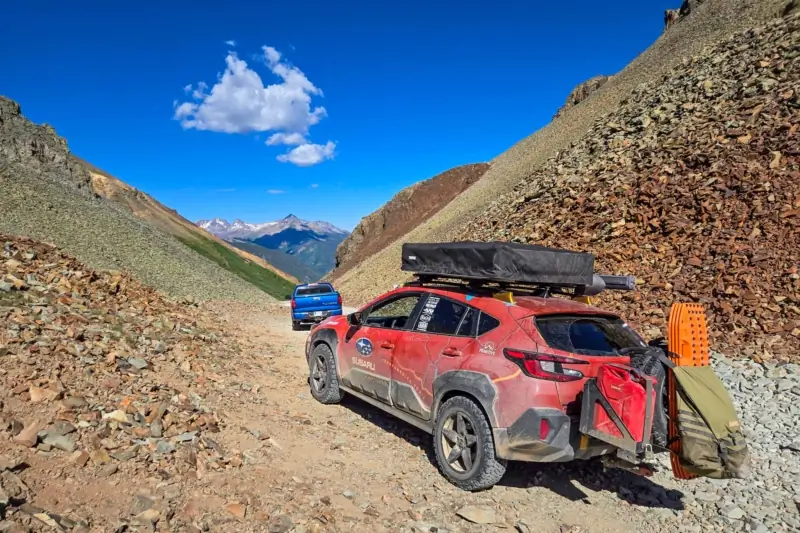



The CTW punches above its weight off-road, even when stock. Adding basic modifications, like better tires, a lift, and armor, will make it so you can venture out farther and over rougher terrain. But remember, while capable for a crossover, it’s not a hardcore trail tamer. Be careful about what kind of terrain you venture through; you can easily get into trouble.
Our TAT CTW took us over terrain I didn’t expect to conquer, it’s still not as off-road capable as a true 4×4, however, such as a Ford Bronco, Jeep Wrangler, or Toyota 4Runner. These rigs have a low-range transfer case for off-road use, larger tires to scale obstacles, and axles designed for serious off-road use.
While Subaru’s computer-controlled X-MODE is very good in the dirt, it isn’t a substitute for a low-range transfer case. The automatic transmission, a CVT, is better suited to efficiency than off-road performance.
That said, a CTW will take you places many other vehicles can’t. But knowing your own limits as a driver are important, too. Don’t go down roads or trails that your driving ability can’t match.
Should you opt for a Subaru Crosstrek Wilderness as an overland vehicle, you’ll get a great mix of on- and off-road comfort, impressive capability, and surprising durability. Just make sure you’re thoughtful about your upgrades, learn to save space, and keep the weight down. With these key bits of advice, you might be surprised how livable and capable it can be.
Read the full article here




